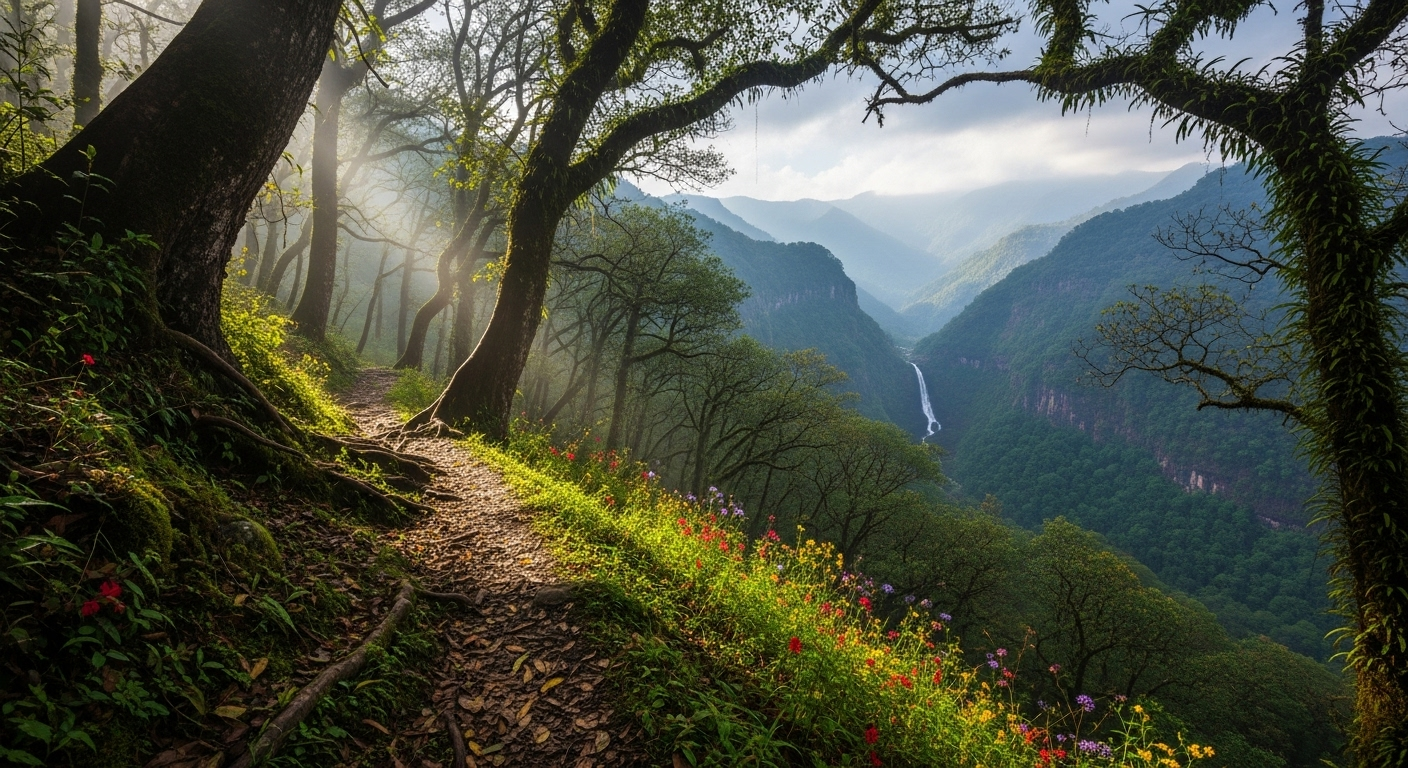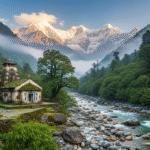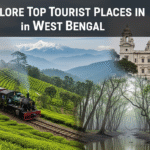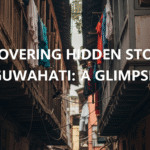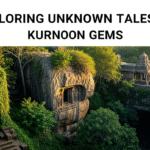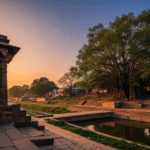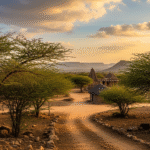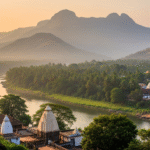Many places love to showcase their visitor counts. Yet, in Northeast India’s lush, hilly lands, a quieter story is told. In Longwa village, 42 kilometers from the busy streets of Mon town, a unique cross-border culture thrives. It’s unnoticed by most tourists. This area doesn’t just have one or two secret spots. Instead, it’s home to about 27 vibrant Konyak villages. Each one is alive with a rich, unique culture, right on the Myanmar border. These hidden spots in Nagaland keep a lively culture, stunning landscapes, and deep history. And they are untouched by the outer world.
Nagaland’s heritage is rich and deep. Houses in Shangnyu village have been standing for over 500 years. Meanwhile, just 65 kilometers from Mon, the Singphan Elephant Reserve is a haven. It’s not only a home for majestic elephants but also a critical zone for biodiversity in the North Eastern Region. Here, away from the usual tourist paths, Nagaland offers peace and beauty hard to find elsewhere. Places like Dzukou Valley rise to 2,452 meters above sea level. They are easy to reach and have low entrance fees, welcoming everyone.
Key Takeaways
- Experience the uncharted culture of Nagaland’s Longwa village, straddling international borders.
- Delve into the history that resonates through the centuries-old structures of Shangnyu village.
- Witness the expansive biodiversity preserved within the Singphan Elephant Reserve.
- Ascend into the clouds and capture panoramic views in Dzukou Valley’s breathtaking high-altitude terrain.
- Seek adventure beyond common tourist maps in Nagaland’s enigmatic, unsullied destinations.
Introduction: The Enigma of Nagaland’s Landscape
Nagaland is a special place in India’s northeast. It is known for its immense mystery and beauty. This state is surrounded by the Seven Sisters and has many hills and green places. It’s perfect for those wanting to see new and hidden places in Nagaland. There are over 220 ethnic groups in Nagaland. Each brings its own culture and beauty to the area.
Nagaland is easy to explore, even if people think it’s remote. It’s full of life and has many natural and cultural spots. The state works hard to keep its nature and culture safe. This makes it welcoming for both researchers and tourists. They all love to find the hidden spots in Nagaland.
You can find many places to stay in Nagaland. They range from simple homes in local villages to fancy hotels. This makes it easy for visitors to enjoy Nagaland’s unexplored spots without giving up comfort. This shows that Nagaland is more accessible than some might think. It’s also great for travelers.
| Feature | Description |
|---|---|
| Cultural Diversity | Nagaland is home to more than 220 ethnic groups, imparting a diverse cultural landscape. |
| Natural Attractions | Expansive jungles, majestic rivers, and compelling mountain ranges dominate the region. |
| Accommodation | Varied options from community homestays to luxury resorts cater to all preferences. |
| Accessibility | Contrary to assumptions, Nagaland’s growing infrastructural developments facilitate easier access. |
Nagaland is not only beautiful but also rich in history and culture. It’s important for anyone wanting to learn more about India’s northeast. There, you can discover many stories and places.
Unspoiled Beauty at the Borders: Longwa Village
Longwa Village sits on the edge of India and Myanmar. It is one of the lesser-known places in Nagaland. This village gives a special look into Nagaland’s rich culture. It has the amazing feature of dual citizenship. Here, the village chief’s house is split between two countries.
The Nagaland’s natural beauty shines in Longwa. It has breathtaking scenes. The people here hold tightly to their old ways. This place is like a museum showing off Nagaland’s history. Every corner has a story that mixes the past with today’s colors.
Experience Dual Citizenship Culture
In Longwa, you can see how the Konyak tribe lives with two citizenships. They belong to both India and Myanmar. This unique mix shows how history shapes culture today. It’s a big part of Nagaland’s diverse culture.
Natural Attractions: Doyang River and Shilloi Lake
The clear Doyang River and calm Shilloi Lake are gems of Nagaland. They attract nature lovers and photographers. Shilloi Lake is in Lutsam village. It’s loved for its legends and peace.
The Heritage of Headhunters: The Konyak Tribe
The Konyak tribe is known for its history of headhunting. Now, they’re famous for wood carving and making guns. They keep their traditions alive with modern touches. They celebrate their culture with tattoos, clothes, and the Aoleang Festival.
In conclusion, Longwa Village shows the rich culture and untouched nature of Nagaland. It offers learning and stunning views. This place has beautiful lands and people.
Shangnyu Village: Living History Among the Konyak
Shangnyu Village is a key example of Naga culture, showing the Konyak tribe’s traditions. It lies in Mon’s heart, blending history and culture with daily life. The Angh’s house, very old and important, has beautiful wood carvings made by heavenly beings.
The legendary house acts as a museum, teaching about the Konyak’s long-standing traditions. Every carving and artifact in the Angh’s house has its own tale. These stories reflect the rich history of civilizations living here for centuries.
| Feature | Details |
|---|---|
| Age of Angh’s House | Over 500 years |
| Key Attraction | Wooden carvings and artifacts |
| Cultural Significance | Reflective of Konyak society and traditions |
| Visitor Experience | Educational insight into ancient tribal customs |
Visitors to Shangnyu quickly notice its natural beauty and rich history. It feels like a living museum where past and present meet. Here, history is kept alive not in cases, but through the people and their customs.
Veda Peak: Magnificent Views atop Mon’s Tallest Mountain
Veda Peak, or Pak Koi, is Mon’s tallest mountain. It has amazing views and a special spot to see Nagaland’s mountains. Going to the top is tough but worth it. You’ll see beautiful rivers and old British opium farms.
You can visit Veda Peak from 6:00 AM to 5:00 PM every day. Entrance is free. Not many tourists go there. But remember to bring water and snacks. Good hiking shoes are a must.
It’s a good idea to hire a local guide. They can help find the way. Plus, they teach you about local life, especially in Konyak villages. These villages add something special to your hike.
| Activity Details | Recommendations |
|---|---|
| Trekking and Photography | Carry essentials and respect local customs |
| Guide Hiring | Suggested for better navigation |
| Amenities | Lack of facilities; bring water and snacks |
| Best Time to Visit | Open Year-round, check local conditions |
Nagaland’s corner has something for adventurers and nature lovers. With its lush scenery and rolling hills, Veda Peak is a treat. It’s great for both hiking challenges and peaceful views. This place shows the beauty of Nagaland’s wild areas.
Unexplored destinations in Nagaland: Singphan Elephant Reserve
The Singphan Elephant Reserve sits among Nagaland’s lush green spaces. It’s not only a sanctuary but also a path for Asiatic elephants. Next to Assam’s forests, it helps these elephants move freely, underlining Nagaland’s commitment to conservation.
Discovering the Elephant’s Haven
In this reserve, you can see Nagaland’s wildlife up close. Covering 5,825 acres, it safeguards elephants and other species. With 446 elephants, it’s key for research and protecting Nagaland’s nature.
Biodiversity Hotspot and Endangered Species
The reserve showcases Nagaland’s biodiversity. It’s home to elephants, tigers, leopards, and the Blyth’s Tragopan. Protecting these species shows the balance of life here, making it important for Nagaland’s biodiversity.
Conservation in Singphan Elephant Reserve benefits ecology and local communities. This balance aids both nature and the people living off the land. It shows how protecting the reserve helps keep the ecosystem vibrant and safe.
Visiting the reserve lets you see conservation efforts firsthand. It highlights the work being done to protect Nagaland’s diverse wildlife.
Mon Town’s Vibrant Local Markets
Mon Town’s markets are full of Naga culture’s energy. They show the depth of Nagaland’s traditions in daily life. These markets are places where people trade goods and share their culture.
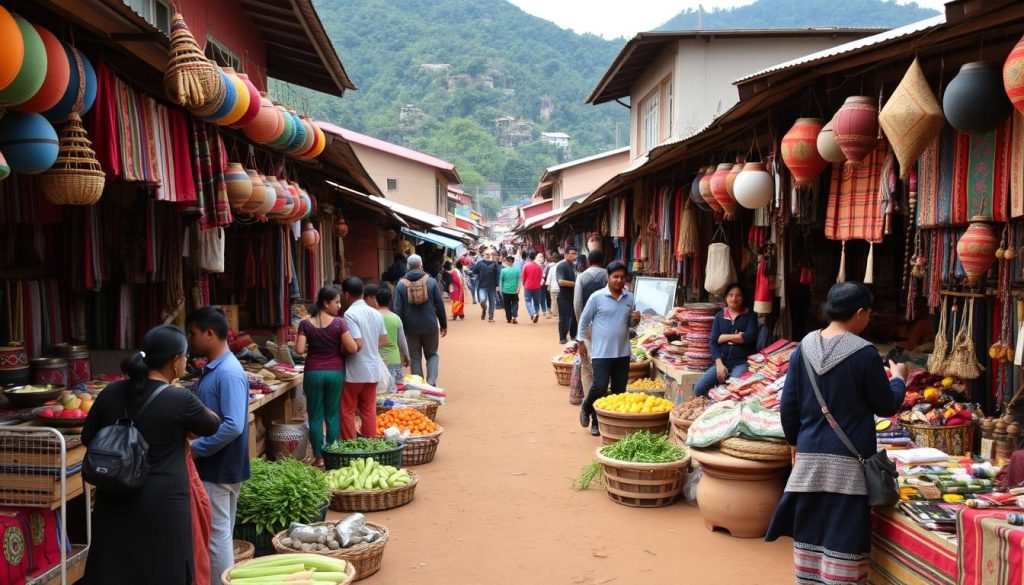
Walking through the markets, visitors see many stalls. Each one shows a part of local life. There are fresh vegetables and exotic foods like dried rat. These markets give a unique taste of the region.
Goods are traded in ways that honor Naga ancestors. This keeps cultural traditions alive.
- Fresh Produce: Colorful vegetables and fruits from nearby lands.
- Traditional Handicrafts: Beautiful carvings and weavings from the Konyak tribe.
- Exotic Delicacies: Unique foods and drinks that show Naga cuisine’s adventurous side.
Nagaland’s markets are more than places to buy things. They bring community and culture together. Visiting these markets helps people understand the Konyak tribe’s strong culture.
Going to Mon Town’s markets is a deep dive into Naga culture. It’s where the spirit of Naga comes alive. These markets are important for anyone wanting to see Nagaland’s cultural wealth.
Revel in the Wilderness of Dzukou Valley
Dzukou Valley, in Nagaland, is a top spot for nature walks. It’s known for beautiful views and lots of plants and animals. The valley sits high up and is full of colorful flowers all year.
The walk in Dzukou Valley is like moving through a painting. You’ll see bright flowers and mountains. It’s a dream place for photographers and those who love to hike.
When you trek in Nagaland, you can find hidden caves. A South Korean Buddhist nun found peace in one in 2011. She stayed for days with just a few things, in a place perfect for quiet thinking.
Getting into one cave is tough. It’s up a steep hill, marked by a simple pole. Once you’re up, you’ll see a stone wall that fits right into the valley’s natural look.
“Dzukou Valley is more than just a travel destination; it’s a portal to profound tranquility and raw nature,” remarked an old villager from Thanamir, who also shared tales of his past as a rebel fighter and now as a passionate advocate for peace and conservation in Nagaland.
Going to Dzukou Valley takes some planning. You can take a weekly helicopter from Kohima to Thanamir. This shows how special and remote the valley is.
Visitors should help keep the valley beautiful. There are special areas to help animals stay safe. This way, Dzukou Valley remains a beautiful place for everyone.
In Dzukou Valley, you’ll see amazing sights and help protect nature. It’s a place with a big heart for keeping the land and its stories safe.
The Melody and Rhythms of Mokokchung
Mokokchung is the heart of Naga music and dance. It’s a bright spot in Nagaland’s culture. This town is known for its Mokokchung cultural hub. It has lovely music and dance that show Naga traditions. It really stands out, touching the hearts of those who visit.
For people who love exploring Naga culture and off the beaten path travel Nagaland, Mokokchung is perfect. It’s beautiful and filled with real culture. The town is not just pretty. It’s also full of life and cultural spirit.
A Hub for Music and Dance
Mokokchung is the center of Naga music and dance. It has many festivals that show its vibrant culture. Every dance and song here has deep roots in history and community. It’s a great place for those wanting to feel Nagaland’s true spirit.
Scenic Beauty and Cultural Exploration
The lush landscapes and green hills highlight Mokokchung’s lively culture. This beautiful environment supports lots of plants and animals. But it also tells cultural tales through dances and old songs. The town offers a full view of Naga traditions, made better by its beauty.
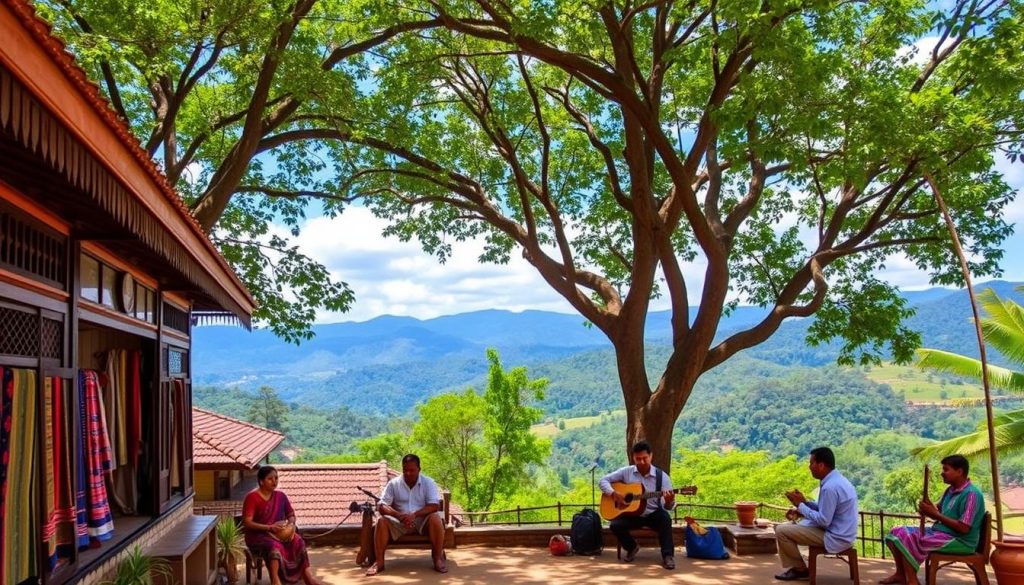
Mokokchung is known as a lively cultural spot in Nagaland. Its art forms show in everyday life and nature. Here, music and dance are part of life. They make a symphony that honors Naga heritage for all visitors.
Off the Tourist Trail: Exploring Tuophema Village
Tuophema village is only 40 kilometers from Kohima. It shows visitors the rich culture of Nagaland. It’s great for those looking for real culture and quiet away from crowded places. This village shows what Naga life is like. It also lets visitors enjoy its peaceful, untouched surroundings.
The village is run by the local community in a sustainable way. Visitors get a real experience in its 12 tourist huts. These huts have traditional Naga designs and were built by the villagers. This helps the local economy and keeps their way of life and architecture alive.
Tuophema offers cultural programs to enrich the visitor’s experience. You can explore local dance and music, which are key to the village’s feel. These activities help visitors truly understand Naga culture. Festivals, like the Sekrenyi in February, show the Angami tribe’s spiritual side and community feeling.
- Guided tours let visitors learn about daily life and the surrounding scenery.
- Cultural performances make the visit educational and fun.
- For those who love adventure, there are treks to nearby mountain tops.
- Trying local cuisine is a must, with millet for breakfast and rice dishes for lunch.
Getting to Tuophema is easy with a bus from Kohima at 1 pm every day, except Sundays. For those preferring a taxi, the cost from Kohima is around 1000 INR. This makes the village easy to visit for a day or a longer stay. It’s especially nice in winter or during festivals.
“Tuophema village exemplifies the preservation of cultural authenticity while embracing tourism. Our aim is to offer a window into our traditions while ensuring our livelihoods are sustainably enhanced through responsible tourism.”
Visiting Tuophema village is a way to deeply engage with its culture and support the locals. Guests will feel the warmth of the villagers, enjoy the calm setting, and experience exciting culture. This village welcomes anyone who wants to learn, respect, and delight in the Naga people’s enduring spirit.
Conclusion: The Uncharted Charms of Nagaland
Nagaland is a place of wonder, full of nature and culture. It draws in bold travelers. Each step in its uncharted paths is an exciting adventure. Dzükou Valley offers stunning sights, perfect for those who love to hike.
People visiting Nagaland feel the warmth of its communities. The Ao Naga tribe in Mokokchung shows the area’s rich culture. History whispers in Unakoti’s age-old sculptures. Places like Mawlynnong and Ziro Valley also have deep traditions and natural beauty.
Nagaland is a unique treasure in India known for its diversity. It invites travelers to explore its rugged beauty. It has lush places like Meghalaya, known as ‘the Scotland of the East’. Nagaland’s green lands and vibrant culture offer an unforgettable journey.
FAQ
What are some secret spots in Nagaland that most tourists haven’t discovered?
Nagaland has secret spots like Longwa Village. This place shows a unique culture of dual citizenship. Another spot is Shangnyu Village, known for the Konyak tribe’s heritage. The Singphan Elephant Reserve is also a must-see for its amazing biodiversity.
Can you suggest undiscovered locations in Nagaland for an off the tourist trail experience?
Off the beaten path in Nagaland, you’ll find Veda Peak’s rugged beauty. Mon town’s vibrant local markets are full of life. Tuophema Village offers a traditional glimpse into Nagaland’s beauty.
Are there cultural experiences to be had in Nagaland’s lesser-known places?
Yes, for cultural experiences, Longwa Village is perfect. You’ll learn about the Konyak tribe’s fascinating history. In Mokokchung, music and dance activities showcase the rich Naga culture.
What natural attractions can I explore in Nagaland?
For nature lovers, Nagaland offers the scenic Doyang River and Shilloi Lake. The Dzukou Valley is perfect for trekking and wildlife sightings. Don’t miss the Singphan Elephant Reserve, a haven for diverse species.
Where can I learn about the Konyak tribe’s heritage?
Learn about the Konyak tribe in Longwa Village and Shangnyu Village. Experience traditional Naga village life. See historical artifacts and intricate wooden carvings at the Angh’s house.
How can I experience the natural beauty of Nagaland?
Nagaland’s natural beauty is unmatched. Trek to Veda Peak for stunning views. Explore the untouched Dzukou Valley. Observe wildlife in the Singphan Elephant Reserve.
What wildlife can I see in Nagaland’s ecological zones?
In Nagaland, the Singphan Elephant Reserve is home to elephants, tigers, and leopards. You might also spot the rare Blyth’s tragopan bird.
Can I observe traditional crafts and daily life in Nagaland’s local markets?
Yes, Mon town’s local markets are full of traditional crafts and daily life scenes. Sample unique Naga delicacies there too.
What makes Mokokchung a cultural hub in Nagaland?
Mokokchung is a cultural hub because of its lively social scene. It’s known for traditional festivals and music. Dance here reflects the rich Naga culture.
How does Tuophema Village offer an authentic cultural experience?
Tuophema Village invites visitors to stay in traditional Naga huts. Participate in community life. Learn about customs and history through guided tours and cultural activities.
